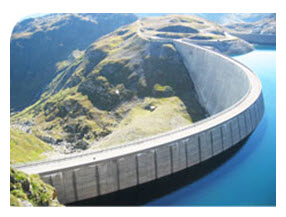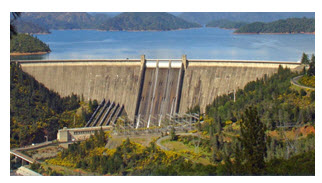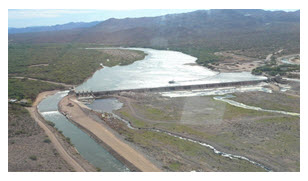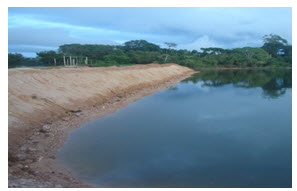Site pages
Current course
Participants
General
Module 1: Fundamentals of Reservoir and Farm Ponds
Module 2: Basic Design Aspect of Reservoir and Far...
Module 3: Seepage and Stability Analysis of Reserv...
Module 4: Construction of Reservoir and Farm Ponds
Module 5: Economic Analysis of Farm Pond and Reser...
Module 6: Miscellaneous Aspects on Reservoir and F...
5 April - 11 April
12 April - 18 April
19 April - 25 April
26 April - 2 May
Lesson 4 Reservoir/Dam and Farm Ponds
4.1 Definition
A dam may be defined as an obstruction or a barrier built across a stream or a river. At the upstream of this barrier, water gets collectedforming a pool of water. The side on which water gets collected is called the upstream side, and the other side of the barrier is called the downstream side. The lake of water which is formed upstream is often called a reservoir, or a dam reservoir, or a river reservoir, or a storage reservoir.
The water collected in this reservoir can be supplied for irrigating the farm lands through a system of canal network, or may be supplied for drinking purposes. The lake so formed can be used for recreation uses also. The energy of this collected water can be used to turn the blades of a turbine to generate electrical power. And in times of floods, the dams can serve as protections for the towns and cities farther down the river.
Apart from these numerous advantages and uses (such as navigation, irrigation, electricity, flood control, etc.) of a dam, it sometimes helps us in planning war strategy and helps us in controlling the advanceme0nt of enemies and their forces. Dams have been frequently opened in times of war. The Dutch breached their dikes during second world war to bedevil the invading Germans, Chinese used to marauders, partly destroyed the famous Dnieprostroi Dam in the Ukraine to keep its power plant from failing into the hands of Hitler’s men.
4.2 Classification of Dams
Dams can be classified depending upon the materials used for construction, use and design as follows:
4.2.1 Classification According to the Material used for Dam Construction
The dams classified according to the material used for construction are of seven types. Three of them are of ancient origin and four have come into general use only in the last century. The dams of ancient origin are:
Earth dam
Rock-fill dam
Solid masonry gravity dams
The dams introduced in the last century are:
Hollow masonry gravity dams
Steel dam
Timber dams
R.C.C Arch dam
(1) Earth Dam: Earth dams are made of soil that is pounded down solidly. They are built in areas where the foundation is not strong enough to bear the weight of concrete dam, and where earth is more easily available as a building material compared to concrete or stone or rock (Fig. 1).

Fig. 4.1. Cross sectional view of earth dam. (Source: Nelson, 1985)
(2) Rock-fill dam: Rock-fill dams are formed of loose rocks and boulders piled in the river bed (Fig. 2). A slab of reinforced concrete is often laid across the upstream face of a rock-fill dam to make it water-tight.
(3) Solid masonry gravity dam: These dams are big in size and quite expensive to be built but are more durable and solid than earth and rock-fill dams. They can be constructed on any dam site, where there is a natural foundation strong enough to bear the heavy weight of the dam (Fig. 3).
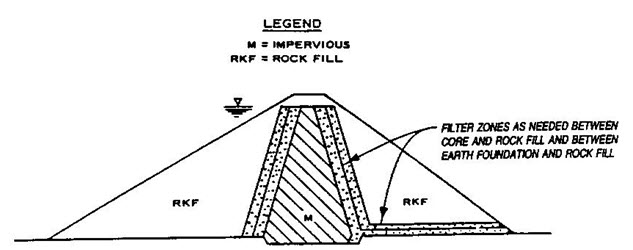
Fig. 4.2. Cross sectional view of rock fill dam.
(Source: http://www.enggpedia.com/civil-engineering)
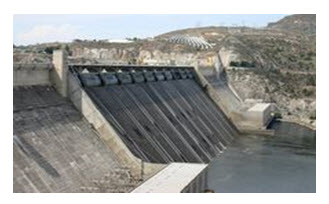
Fig. 4.3. Photograph of a Solid masonry gravity dam.
(Source: http://en.wikipedia.org/wiki/File:Grand_Coulee_Dam_spillway.jpg)
(4) Hollow Masonry Gravity Dam: It is essentially designed on the same principle of solid masonry gravity dams. But the difference is that it contains less concrete or masonry to the tune of 35 to 40%. Generally, the weight of water is carried by a deck of R.C.C. or by arches that share the weight burden. It is difficult to construct this type of dams and is adopted only if highly skilled labour is available. Otherwise the labour cost becomes too high to construct such complex structure.
(5) Steel Dam: Today, steel dams are used as temporary coffer dams required for the construction of permanent dams. Such coffer dams made of steel are usually reinforced with timber or earth-fill (Fig. 5).
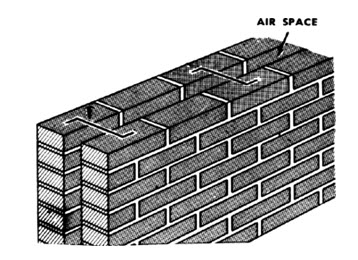
Fig. 4.4. Hollow masonry gravity dam.
(Source: http://encyclopedia2.thefreedictionary.com)
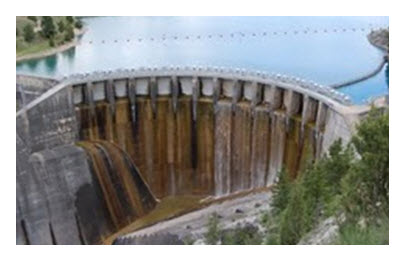
Fig. 4.5. Photograph of a steel dam.
(Source: http://roadtrekin.blogspot.in/)
(6) Timber Dam: These dams are short lived because rotting sets in a few years time. In spite of regular maintenance, the life of a timber dam is not more than 30 to 40 years. However, these are useful for low level needs in agricultural sector (Fig. 6). For example, a cattle-raiser may need a pool for the purpose of drinking and bathing of his livestock and other related needs.
(7) Arch Dam: Arch dams are very complex and complicated. They make use of horizontal arch action in place of weight to hold back the water (Fig. 7). They are best suited at sites where the dam must be extremely high and narrow.
|
Fig. 4.6. View of a timber dam. |
Fig. 4.7. View of an Arch dam. |
(Sources: http://civilsolution.wordpress.com/ , http://www.stucky.ch/)
4.2.2 Classification of Dams According to their Use
Based on the use, the dams are divided into three types such as storage dams, diversion dams and detention dams.
(i) Storage Dam: These dams are constructed to store water during the periods of surplus supply and the stored water is used later during the periods of deficient supply (Fig. 8). In countries like India,where the rainfall pattern is very erratic, huge amount of rainfall received during monsoon months flows down wastefully and later on when the crops suffer from drought due to dry spells. The water stored by these dams during rainy season is used for irrigation to the crop fields during dry spells as well as in post-monsoon period. The other uses of these water sources may be for town water supply, pisciculture, navigation, recreation, electricity generation etc.
(ii) Diversion Dam: These are small dams used to raise the water level in the rivers in order to feed off-taking canals or some other conveyance systems. A diversion dam is generally called as a weir or a barrage based on its design specifications (Fig. 9). It is a very useful component in irrigation projects.
(iii) Detention Dam: Flood in rivers during rainy season is a common phenomenon in India. It happens so due to sudden in-rush of runoff from the upper reaches of the river. Detention dams are constructed at various locations of head water tributaries to retard the flood runoff and detain the flood water temporarily (Fig. 10). Thus, the adverse effects of sudden flood are minimized. Sometimes the detention dams are used to trap sediments and so also called debris dam.
|
Fig. 4.8. View of a Storage dam. |
Fig. 4.9. View of a Diversion dam. |
|
|
|
|
Fig. 4.10. View of a Detention dam. (Sources: http://www.azwater.gov, http://www.internationalrivers.org/) |
|
4.2.3 Classification of Dams According to Hydraulic Design
Based on the hydraulic design, the dams are divided into three types such as overflow dams, non-overflow dams, rigid dams and non-rigid dams.
(i) Overflow Dam: An overflow dam is designed topass the surplus water over its crest. So, these dams are also called spillways. While choosing the materials for construction of these dams,care should be taken to see that they are non-erodible under such discharges.
(ii) Non-Overflow Dam: These dams are not designed to be over-topped. This type of design gives us wider choice of materials including that of earth-fill and rock-fill dams.
Many a time, the overflow and the non-overflow dams are combined together to form a composite single structure.
(iii) Rigid Dam: Rigid dams are those which are constructed of rigid materials like masonry, concrete, steel, timber, etc.
(iv) Non-Rigid Dam: The non-rigid dams are constructed of earth and rock-fill. Discussion on earth and rock-fill dams has been made in section ---.
4.3 Selection Criteria of a Dam
Whenever we decide to construct a dam at a particular place, the first baffling problem before us is to choose the right type of dam. Suitability and economic viability of the dam are the most vital points to be considered. The most economical one among the list of technically feasible dams should be the first choice of the planners while selecting a dam. Various designs and their estimates of the dams are to be prepared before recommending a particular type of dam. Various factors which must be thoroughly considered before selecting a dam are described below:
4.3.1 Topography
The land configuration otherwise known as the topographyof the location, where the dam is to be constructed, is considered to be the foremost criterion for deciding the type of dam. For example:
A narrow U-shaped valley obviously allows a narrow stream of water flowing between high rocky walls at its both sides. A concrete overflow dam is usually recommended for this condition.
A low rolling plain landscape would naturally suggest an earth-fill dam with a separate spillway.
Availability of spillway site is also very much important while selecting a particular type of dam.
A narrow V-shaped valley indicates the choice of an arch dam. The ratio of the top width and the height of the valley, where the dam is to be constructed, should be preferably less than or equal to 1:4. In this condition, it may not be possible to have the spillway as an integral part of the dam. Rather it is suggested to have a separate site for the spillway.
4.3.2 Geology and Foundation Conditions
The natural foundation, on which the dams are to be constructed, should carry the weight of the dam. The dam site must be thoroughly surveyed by geologists, so as to detect the thickness of the foundation strata, presence of faults, fissured materials, and their permeability, slope and slip etc.
Various kinds of foundations generally encountered are discussed below:
Solid Rock Foundation: Solid rock foundations such as granite, gneiss etc. have a strong bearing power. They offer high resistance to erosion and percolation.Almost every kind of dam can be built on such foundations. Sometimes, seams and fractures are present in these rocks and they must be grouted and sealed properly.
Gravel Foundation: Course sands and gravels are suitable for earth and rock-fill dams as they are unable to bear the weight of high concrete gravity dams. Low concrete gravity dams up to a height of 15 m may be suggested on such foundations.These foundations have high permeability and, thereforesubjected to water percolation at high rates. Suitable cut-offs must be provided to avoid the danger of undermining.
Silt and Fine Sand Foundation: Silt and fine sand foundation is suitable for earth dams or very low gravity dams(up to height of 8 m). A rock-fill dam on such a foundation is not suitable. Seepage through such foundation may be excessive. Settlement may also be a problem. Such foundations are vulnerable to erosion at the downstream toe and so necessary protection against such erosion must be ensured.The dams on such foundation must be properly designed to avoid such dangers.
Clay Foundation: Unconsolidated and high moisture clays are likely to cause enormous settlement of the dam. Concrete gravity dams or rock-fill dams are not suitable in such foundations. Earthen damsafter special treatment may be recommended for such foundations.
Non-uniform Foundation: At certain places a uniform foundation of the types described above may not be available. In such cases, a non-uniform foundation of rock and soft material is to be used for construction of the dam. Such unsatisfactory conditions are to be dealt with by special designs. However, every problem is an individual problem and a solution has to be found by experienced engineers. For example- the Jawahar Sagar dam in Rajasthan offers such problem. A bed of clay,if encountered,between the base of the dam and solid rock foundation, it is not economically feasible to remove it. In such condition, the problem is sorted out through anchoring of the base of the dam to the foundations below by means of pre-stressed cables.
4.3.3 Availability of Materials
In order to achieve economy in dam construction, the materials required for it must be available locally or at short distances from the construction site. Sometimes, good soil is easily available, which naturally calls for an earthen dam. If sand, cement and stone etc. are easily available, one should naturally think of a concrete gravity dam. If the material has to be transported from far off distances, then a hollow concrete dam(Buttress) is a better choice.
4.3.4 Spillway Size and Location
Spillway, as discussed earlier, disposes the surplus river discharge. The capacity of the spillway depends on the magnitudes of the floods to be by-passed. The spillway will, therefore, become much more important on streams with large flood potential. On such rivers, the spillway becomes a primary structure and the type of dam becomes a secondary consideration.
The cost of construction of a separate spillway may be enormous or sometimes a suitable separate site for the spillway may not be available. In such cases, it is desirable to combine the spillway and the dam as one structure leading to adoption of a concrete overflow dam.
At certain places, where the excavated material from a separate spillway channel can be utilized in dam embankment, an earth-fill dam may prove to be advantageous. Small spillway requirement often favours the selections of earth-fill or rock-fill dams even in narrow dam sites.
The practice of building a concrete spillway on earth and rock embankments is being discouraged these days, because of their conservative design assumptions and the vigil and watch required during their operations.
4.3.5 Earthquake Zone
If the dam is to be situated in an earthquake zone, its design must include the earthquake forces. Its safety should be ensured against the increased stress induced by an earthquake of worst intensity. The type of structures best suited to resist earthquake shocks without danger are earthen dams and concrete gravity dams.
4.3.6 Height of the Dam
Earthen dams are usually not provided with heights more than 30 m or so. Hence, for greater heights, gravity dams are generally preferred.
4.3.7 Other Considerations
Various other factors such as the life of the dam, the width of the roadway to be provided over the dam, problem of skilled labour, legal and aesthetic points must also be considered before a final decision on dam. However, the overall cost of construction and maintenance; and the funds available will finally decide the choice of a particular kind of dam at a particular site.
4.4 Introduction and Classification Farm Ponds
4.4.1 Introduction
Farm ponds are the most commonly used sources of ex-situ water harvesting structures. In addition to receiving direct rainfall, provision is also made to allow the runoff, generated from the upper reaches, to enter into it.It has wide adaptability in farmers’ fields and is used as a handy source of water supply to crop fields. Such ponds are in use since time immemorial not only as assured sources of water supply to crops but also for pisciculture, livestock consumption and meetingthe demands from other sectors etc. However, these ponds have wide variations in shape and size as per the method of construction and their suitability to different topographic conditions. Most of the ponds, initially, constructed in fields are of regular shape. As time progresses,these ponds lose their regular shape and become irregular due to poor repair and maintenance.
4.4.2 General Classification of Pond
Based on the method of construction, location and purpose of use, the farm ponds are divided into several types. A general classification of farm ponds is discussed below:
Dugout pond
Surface pond
Spring or creek fed pond
Off-stream storage pond
Seepage pond
Pump-fed pond and
Embankment pond
(i) Dugout Pond
Dugout ponds also called excavated ponds as they are constructed by digging the soil. Ideal location for this pond is flat topography. The excavated soil is used in construction of embankments around the ponds. These ponds collect in-situ rainwater, surface runoff from the adjacent catchments and groundwater. The harvested water is lifted by means of indigenous lifting devices and pumps forvarious purposes such as irrigation, domestic water supply, livestock consumption etc. Excavated ponds are usually generally designed with a regular shape. The conventional shapes of the ponds may be square, rectangular or circular. Out of the three shapes, the circular pond has the highest storage capacity and the least perimeter for a given surface area and side slope. A comparison has been shown in Table 2.1.
Table 2.1. Perimeter and storage capacity of different shaped farm ponds
|
Shape of pond |
Side slope |
Perimeter (m) |
Storage capacity (m3) |
|
Circular |
1:5:1 |
105 |
1499 |
|
Square |
1:5:1 |
120 |
1464 |
|
Rectangular |
1:5:1 |
122 |
1458 |
N.B.: Each pond has equal surface area of 900 m2 and equal depth of 2 m.
However, it is difficult to construct circular shaped ponds. Therefore, the square and rectangular shaped ponds are widely adopted. For the same sizeof pond, the total dike length is more in case of rectangular shape than a square one. The perimeter of the pond increases as the shape gets more and more elongated resulting in increase of the construction cost. The dimensions and perimeter ofdifferentfarm ponds having same size of 400 m2 are presented in Table 2.2.
Table 2.2. Dimensions of farm ponds of size 400 m2 and of different shapes
|
Pond shape |
Length: width |
Width (m) |
Length (m) |
Perimeter (m) |
|
Square |
1:1 |
20.00 |
20.00 |
80.00 |
|
Rectangular |
2.1 |
14.14 |
28.28 |
84.85 |
|
3:1 |
11.55 |
34.64 |
92.37 |
|
|
4:1 |
10.00 |
40.00 |
100.00 |
Square ponds are preferred when the pond size is small, less than or equal to 400 m2, because of low construction cost. For ponds larger than 400m2 size, the rectangular ponds are recommended.
(ii) Surface Pond
Surface ponds, also called as excavated-cum-embankment type ponds, are the most common types of farm ponds. They are partly excavated in ground where there is some depression and the excavated soil is used for the construction of the embankments. The dugout soil is utilized for the construction of the embankments of the ponds so that the pond can store maximum amount of water. These ponds are mostly fed by surface runoff although they catch in-situ rainfall and so, at times called as watershed ponds. Normally they get no supply during the dry season. Water from these ponds flows out by gravity till the water level in the pond reaches the ground level and then the rest amount of stored water is pumped out. Selection of site of these ponds is therefore very important.
(iii) Spring or Creek Fed Ponds
Spring or creek fed ponds are those where a spring or a creek is the source of water supply to the pond. Construction of these ponds depends on the availability of natural springs or creeks.
(iv) Off-Stream Storage Ponds
Such ponds are constructed by the side of the streams which flow only seasonally. They are so called since they are used to store the diverted seasonal water of the stream. These ponds also called barrage ponds as they are fed directly by the water running straight out from the water body to the ponds or diversion ponds as the water entering a channel is fed indirectly to the ponds in a controlled manner.
(v) Seepage Ponds
These ponds are supplied with water from the water table by seepage. The water level in the pond will vary according to the level of water table in the adjacent aquifer.
(vi) Pump-Fed Ponds
These ponds are normally at higher level than the water level in adjacent water sources such as a well, spring, lake or irrigation canal and are supplied water from these sources by pumping.
(vii) Levee Pond
These types of ponds are formed by embankments and are usually of a regular shape (rectangular) and are of uniform depth. They are fed with water from wells, storage reservoirs, streams or estuaries. They are mostly used in aquaculture.
4.4.3 Lined and Unlined Ponds
The ponds discussed above may be of lined or unlined types. Unlined ponds have no linings and are otherwise called earthen ponds. They have high seepage losses and hence their storage capacity decreases with time after cessation of rainfall. The rate of seepage losses gradually decreases with deposition of silt in the bottom and sides of the ponds. On the contrary, a lining material is provided either on the sides or bottom or both of the ponds to check the seepage losses in case of lined ponds. Consequently, these ponds have low or even no seepage loss and high storage capacity compared to the unlined ones. The lined ponds are named depending on the types of lining material. Some of the commonly used lined materials are polyethylene, bitumen, clay, brick and cement-concrete etc.
Some more types of ponds based on the purpose of use are walled ponds, drainable ponds, un-drainable ponds, pump drained ponds, cut and fill ponds etc.
Depending on the way the ponds fit in with the features of the local landscape, they have been conveniently grouped into three basic types such as sunken pond, barrage pond and diversion pond.
Sunken Ponds
A sunken pond is leveled with the ground surface and completely dug out. If it is required to have a sunken pond of 4 ft. deep, it needs to be dug 4 ft. down.
Following features are associated with sunken ponds:
The floor of the pond is generally below the level of the surrounding.
The pond is directly fed by groundwater, rainfall and/or surface runoff. It can also be fed by pumping.
It is not drainable or partially drainable.
These are sometimes constructed in the bottom of the valley by building a dam across the downstream end or in a series down the valley.
Barrage Ponds
Barrage ponds are made by building a wall across a small stream and the ponds are, therefore, like small conservation dams. Water for these ponds comes from a springor seepage area. It is very important that ponds of this type should not be constructed in places where there will be a very large flood of water down the stream in the rainy season.Sometimes barrage ponds are made below large conservation dams making use of seepage water. Barrage ponds have the following features:
It is drainable through the river bed.
It may have diversion canal or without. If large floods are present, the excess water is normally diverted around one side of the pond through a diversion canal. The pond water level then is controlled through water intake. Water enters directly to the pond from a spring, reservoir, lake etc. through a point called as inlet and flows out at another point called as outlet.
To protect the pond dike from floods, a spillway is built.
Diversion Ponds
Diversion ponds are constructed by bringing water from another source to the pond.The features of the diversion pond are:
The diversion ponds are fed directly by gravity or by pumping through a diversion canal from a spring, lake or reservoir. The water flow is controlled through a water intake. There is an inlet and outlet for each pond.
They can be constructed either in sloping ground as a cut and fill pond or in a flat ground as a four dike embankment pond sometimes called as paddy pond.
It is usually drainable through a drainage canal.
It is important to note that the choice of a particular type of pond largely depends on the kind of water supply available and on the existing topography of the site selected. For an example, if the valley bottom is 50 to 100 m wide, barrage ponds might be appropriate and when the valley bottom is more than 100m wide, diversion ponds may be built. However, when there are choices of several types of ponds, one should give highest priority to diversion ponds fed by gravity and lowest priority to barrage ponds in flooding areas requiring large diversion canals.
Shallow and Deep Ponds
Depending on the depth of water, the pond may be classified as shallow or deep pond. Except in some barrage ponds built on streams with steep longitudinal slope, fish ponds are generally shallow. Their maximum water depth is limited to 1.5 m. The depth of the pond should be at least 0.5 m to limit the growth of aquatic plants. The water depth in small ponds in many of the rural areas varies from 0.5 to 1 m. It is to be noted that the deeper ponds are much more expensive to excavate because of increasing exposed area and volume of earth works. Furthermore, the lifting of the excavated earth materials becomes difficult and requires more labour works and hence, wages. However it has some advantages too. In dry regions with more evaporation losses, deeper ponds are useful to reduce the evaporation loss and enable the pond users to have enough storage for pisciculture, domestic and agricultural uses. Even in the cold regions, where it may be necessary to provide the fish with a refuge in deep ponds, warmer water is useful during the cold weather.
Keywords: Reservoir, Dam, Farm pond, pisciculture.
References
Panigrahi, B. (2011). Irrigation System Engineering, New India Publishing Agency, New Delhi. pp. 11-12.
Suresh, R. (2002). Soil and water conservation engineering. Fourth edition.
Suggested Reading
Garg, S. K. (2011). Irrigation Engineering and Hydraulic Structures. Twenty Fourth Revised Edition. pp. 811-814.
Murthy, V.V.N. and Jha. M. K. (2011). Land and Water Management Engineering. Kalyani Publication.

